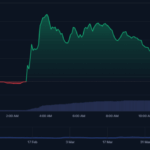
Solana’s Success Benefits Ethereum and the Web3 Ecosystem
This is an opinion piece contributed by Hart Lambur, Co-Founder of Risk Labs (UMA and Across).
Solana’s recent developments haven’t come at Ethereum’s detriment; instead, they have broadened the overall cryptocurrency user community. Rather than drawing existing users away from Ethereum, Solana has acted as an entry point for newcomers to web3. With rapid transaction speeds, minimal fees, and a lively application ecosystem, it has become the ideal platform for the latest wave of memecoin enthusiasts.
Whether one approves of them or not, memecoins like HarryPotterObamaSonicInu and Fartcoin were not merely a distraction; they have introduced millions to the world of cryptocurrency, many engaging for the first time. Solana was where they executed their initial trades, marking their true introduction to the web3 space. Although some users faced financial losses, a portion of them chose to remain active in the space.
The pressing question now is: how can we encourage them to stick around and explore more of what web3 has to offer beyond mere speculation? As noted by Vitalik last year regarding memecoins, this presents a valuable chance to forge something more constructive and enduring.
From Observers to Participants
This surge of new users signifies a unique opportunity for the crypto landscape. At its highest point, Solana’s memecoin surge contributed to a market cap of $47.9 billion. Even though memecoins have seen a decline of 76% since their all-time high in December 2024, Solana played a pivotal role in onboarding genuine users and capital. While the frenzy around memecoins may not last, the individuals they attracted can remain engaged.
The cryptocurrency realm has long aspired for mass adoption, and the current conditions allow for that potential to be realized. However, this growth introduces its own challenges. If newcomers struggle to navigate the expansive ecosystem – restricted to a single blockchain or limited use case – we risk dissipating the momentum, funding, and expansion that accompany it.
The Transition from Acquisition to Retention
Drawing in users is no longer the primary hurdle. Memecoins on Solana have opened avenues for a fresh audience, much like ICOs, DeFi, and NFTs did previously. The real challenge lies in ensuring that the broader web3 ecosystem offers an experience as seamless and user-friendly as the leading blockchains. Solana still feels somewhat isolated from the larger Ethereum ecosystem, similar to how different Ethereum Layer 2 solutions once felt. If we fail to facilitate users’ exploration of various ecosystems after the initial excitement around trends like memecoins dissipates, we risk losing them just as swiftly as they arrived.
Previously, transitioning from one blockchain to another (be it Ethereum, Base, or a different Layer 2) has often felt daunting and expensive. It parallels arriving in an intriguing new city, full of enthusiasm to explore, only to find that the best spots are challenging to access due to inefficient transportation systems. This encapsulates the experience many users face today in crypto: abundant opportunities, yet hindered by obstacles at nearly every step. Nonetheless, this friction is not a given, and we currently possess the means to eliminate it.
Crosschain Solutions as the Answer
Crosschain solutions could provide a viable answer. Standards like ERC-7683 empower web3 applications to execute complex multi-step crosschain transactions as a single user request. Developed by Across and Uniswap, this standard enables developers to simplify the complexities associated with engaging multiple chains while fully utilizing their collective strengths. Users can enjoy the best of both worlds: the straightforwardness of a singular chain coupled with the scalability that multiple chains offer.
A Unified Future
Solana’s recent influx of users underscores how optimizing user experience can facilitate large-scale onboarding. However, onboarding is merely one component of the larger picture – retaining users presents the true challenge. For web3 to genuinely expand, it needs to present itself as a cohesive ecosystem rather than a fragmented collection of networks. Just as ERC-7683 and intents have unified Ethereum Layer 2s, we must aim to provide users with the same smooth interactions on Solana.
Ethereum, Solana, and other chains are not in direct competition. The focus should not be on which chain prevails; instead, it should be about creating a unified, intuitive web3 experience. This necessitates building infrastructure that rapidly connects users across chains, simplifies complexities, and fosters a sense of cohesion throughout the ecosystem. Web3 can only attain scalability when users cease to think of individual chains, much like how internet users do not consider TCP/IP while browsing. This is the vision we are striving to achieve.


















Post Comment